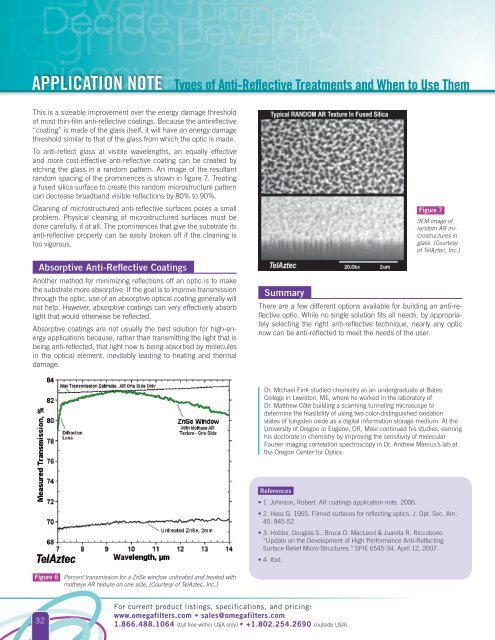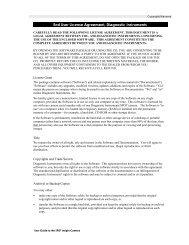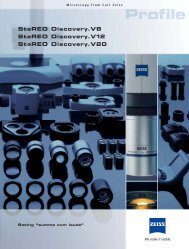optical interference filters - SPOT Imaging Solutions
optical interference filters - SPOT Imaging Solutions
optical interference filters - SPOT Imaging Solutions
Create successful ePaper yourself
Turn your PDF publications into a flip-book with our unique Google optimized e-Paper software.
Types Of Anti-Reflective<br />
Treatments And When To Use Them<br />
application note Types of Anti-Reflective Treatments and When to Use Them<br />
This is a sizeable improvement over the energy damage threshold<br />
of most thin-film anti-reflective coatings. Because the antireflective<br />
“coating” is made of the glass itself, it will have an energy damage<br />
threshold similar to that of the glass from which the optic is made.<br />
To anti-reflect glass at visible wavelengths, an equally effective<br />
and more cost-effective anti-reflective coating can be created by<br />
etching the glass in a random pattern. An image of the resultant<br />
random spacing of the prominences is shown in figure 7. Treating<br />
a fused silica surface to create this random microstructure pattern<br />
can decrease broadband visible reflections by 80% to 90%.<br />
Cleaning of microstructured anti-reflective surfaces poses a small<br />
problem. Physical cleaning of microstructured surfaces must be<br />
done carefully, if at all. The prominences that give the substrate its<br />
anti-reflective property can be easily broken off if the cleaning is<br />
too vigorous.<br />
Absorptive Anti-Reflective Coatings<br />
Another method for minimizing reflections off an optic is to make<br />
the substrate more absorptive. If the goal is to improve transmission<br />
through the optic, use of an absorptive <strong>optical</strong> coating generally will<br />
not help. However, absorptive coatings can very effectively absorb<br />
light that would otherwise be reflected.<br />
Absorptive coatings are not usually the best solution for high-energy<br />
applications because, rather than transmitting the light that is<br />
being anti-reflected, that light now is being absorbed by molecules<br />
in the <strong>optical</strong> element, inevitably leading to heating and thermal<br />
damage.<br />
Summary<br />
Figure 7 <br />
SEM image of<br />
random AR microstructures<br />
in<br />
glass. (Courtesy<br />
of TelAztec, Inc.)<br />
There are a few different options available for building an anti-reflective<br />
optic. While no single solution fits all needs, by appropriately<br />
selecting the right anti-reflective technique, nearly any optic<br />
now can be anti-reflected to meet the needs of the user.<br />
Dr. Michael Fink studied chemistry as an undergraduate at Bates<br />
College in Lewiston, ME, where he worked in the laboratory of<br />
Dr. Matthew Côté building a scanning tunneling microscope to<br />
determine the feasibility of using two color-distinguished oxidation<br />
states of tungsten oxide as a digital information storage medium. At the<br />
University of Oregon in Eugene, OR, Mike continued his studies, earning<br />
his doctorate in chemistry by improving the sensitivity of molecular<br />
Fourier imaging correlation spectroscopy in Dr. Andrew Marcus’s lab at<br />
the Oregon Center for Optics.<br />
References<br />
• 1. Johnson, Robert. AR coatings application note. 2006.<br />
• 2. Hass G. 1955. Filmed surfaces for reflecting optics. J. Opt. Soc. Am.<br />
45: 945-52.<br />
• 3. Hobbs, Douglas S., Bruce D. MacLeod & Juanita R. Riccobono.<br />
“Update on the Development of High Performance Anti-Reflecting<br />
Surface Relief Micro-Structures.” SPIE 6545-34. April 12, 2007.<br />
• 4. Ibid.<br />
Figure 6 Percent transmission for a ZnSe window untreated and treated with<br />
motheye AR texture on one side. (Courtesy of TelAztec, Inc.)<br />
32<br />
For current product listings, specifications, and pricing:<br />
www.omega<strong>filters</strong>.com • sales@omega<strong>filters</strong>.com<br />
1.866.488.1064 (toll free within USA only) • +1.802.254.2690 (outside USA)

















